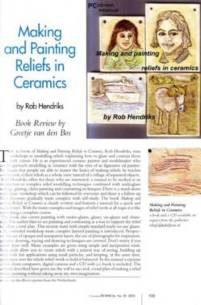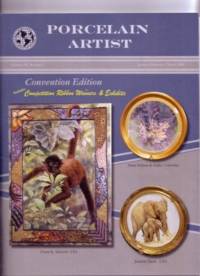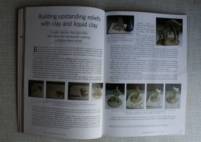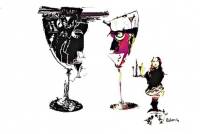Referenties
Hi, I am Rob Hendriks and I like to offer a different view on reliefs and the making of reliefs.
Article in Ceramics TECHNICAL no.20
The author of Making and Painting Reliefs in Ceramics,Rob Hendriks,runs workshops in modelling reliefs explaining how to glaze and contrast them with colour.He is an experienced ceramic painter and modelmaker who likes to approach modelling in ceramics with the eyes of an figurative oil painter. This means that people are able to master the basics of making reliefs;he teaches them to look at their reliefs as a whole view instead of a collage of separated objects. Rob Hendriks offers for those who are intrested,a manual to be studied as an introduction to complex relief modelling techniques combined with underglaze painting,glazing,china painting and contrasting techniques.There is a stand-alone simple basic workshop which can be followed by everyone and there is a follow up which becomes gradually more complex with self-study.The book Making and Painting Reliefs in Ceramics is clearly written and features a tutorial for a quick and practical start.With the many examples and images of relief work at all stages it is like undertaking a complete course. The book also covers painting with under-glazes,glazes,on-glazes and chinapaint. The author likes to see painting and contrasting as a way to support the relief and offers a total plan.This section starts with simple standard ready-to-use glazes. In the extended workshop more complex layered painting is introduced.Perspective, the use of opaque and transparent layers,the use of photographs for inspiration, figurative drawing,tracing and drawing techniques are covered.Don’t worry if you cannot draw well.Many examples are given using simple and inexpensive tools. These tools allows you to create reliefs with a natural way of seeing,building up forms with fast applications using small particles,and keeping,at the same time, supervision over the whole relief-work to hold it balanced.In the manual a separate section about computers,digital cameras and a CD with a e-book is included.The methods described have give me the will to succeed,a total plan of making a relief ceramic painting without taking away my own imagination. Greetje van den Bos is a potter from the Netherlands CeramicsTECHNICAL no. 20 2005
Article in Porcelain Artist no.49
Slippainting with castingclay is easy; you need a piece of plaster,a brush, and castingclay. The castingclay could be clay for earthenware but also porcelain castingclay is suitable. I use the (porcelain)clay if it is paint. On the dry plaster surface I paint a little figure,for example a sea horse.When a layer is dry I paint another layer etc. The layers are drying quick on the plaster. When the figure has dried a little it comes loose from the plaster, sometimes it needs a little help to loose with a paletknive. The pieces are fragile when complete dry and break easy so I transport them earlier (in the leatherhard stage) to a tile(or small kiln plate)with the paletknive. Now I don’t have to touch the little pieces when transporting them to the kiln.Only have to handle the supporting tile with the fragile piece,which gives no problem.This transport system works good and I have seldom breakage. Often I apply on top of the painted claylayers a transparent glaze so I can decorate the pieces after one bisquit/glazing firing with china paint or luster. The small pieces are suitable as piece of jewelry; for example as a pindecoration or pendant. I also make groups of fishes and seahorses which I attach to my reliefs. Rob Hendriks Porcelain Artist no. 49 2009
Article in Ceramics TECHNICAL no.33
ROB HENDRIKS WILL EXPLAIN HIS METHOD OF RELIEF MAKING and how to construct and glue those reliefs so that they become an upstanding relief and become a sculpture.Since low reliefs are usually made on tiles,a method is used to cut out the relief from the tile or slab and to convert it to an upstanding relief sculpture.We will also explain a method for painting a low relief with liquid slip on plaster. A drawing is made with a pencil to the flat surface of a plate of dry plaster.It is the same plaster to make moulds.Then with liquid clayslip,a model is painted into the lines of the drawing with a brush.The painting is done in layers and when a layer is dry,another layer is applied.When the complete model is dry and,sometimes with the aid of a palette knife,the model comes loose from the plaster.The relief is thin and easy to break,so the figure is turned on the plaster and the back of the thin figure is strengthened with fat casting slip.”Often I strengthen the back extra by laying a small ‘thread’ made from throwing clay in the wet slip”.Now the thin figure made with the slip painting on plaster is much stronger. When the figure is dry,it is glued with casting clay(or liquid clay slip) to a pile(to support the construction),so now it becomes freestanding and then the pile is fit into a wet ground plate.(The ground plate is poured with casting clay,also on a flat plaster surface)Because the work is thin,on the backside of the work,layers of casting clay and small thread-like pieces of throwing clay(piles) are attached to strengthen the piece. A variant of this method is sliptrailing on plaster.With a fine slip applicator accurate liquid model work is possible,comparable with the work done with fine modelling tools or brushes.With a slip-trailing bulb,slip is ‘painted on plaster’in a pencil outlined plaster area and when the slip is dry it is loosened from the plaster(sometimes with a little help of a palette knife).With a ground plate and a pile the slip-trailed decoration can be made upstanding and stable.(Often it must be strengthen from the backside with casting slip and small piles or thread like pieces of throwing clay.) (Another method of making a relief is by tracing a drawing or a print to a rolled slab of clay instead of painting with liquid Clay). When a rolled clay slab is in an early leatherhard stage,a print or a drawing can be laid over it and with a pencil or modelling tools the drawing can be traced onto the clay.When removing the drawing after tracing,a sort of sgrafitto in the clay occurs.This sgraffitto can be modelled further easily into a relief by laying a sheet of transparent plastic(for example the plastic that is used for deep freezer bags)over the clay and working further with modelling tools and /or by adding layers of liquid slip to raise.When ready the relief is cut out of the slab with a knife.The relief is glued to a pile and the pile is attached to a poured(on plaster)wet ground plate.Now the upstanding relief is stable. Any sort of building can be made but also figures and other forms.Needed are;The building stones,casting clay or liquid clay,a pile or frame,and a ground plate. The building stones are thin and can be made in different ways.One good way is to paint a layer casting clay to a sheet of paper.When the casting clay has dried,it breaks easily into individual stones.(to hasten drying time;the sheet with the casting clay can be heated for example in the kitchen oven.) Casting clay(or liquid slip) is used to attach(glue)the stones to a pile or frame.The pile or frame is made by hand from throwing clay. “The groundplate is easy to make and I start with it.I pour casting clay(sometimes with grog,depending of the size of the work)on a plate of plaster.In the wet clay,I set up the pile or frame(made from throwing clay),then the stones,which I first moisten,are attached to the pile with casting clay” “Often I apply layers of casting clay or liquid slip or extra piles on the back side of the work to strengthen thin parts.On top of these layers I put a finish,such as a vitreous engobe or a glaze.” ————————————————————————————————— Rob Hendriks and Greetje van den Bos are potters in the Netherlands.Their website is http://www.reliefs.nl CeramicsTECHNICAL no. 33 November2011
Voorjaar 2015; mijn werk ‘cheers’ is opgenomen in het zeer fraaie boek ‘Cohen’s Choice’.
'cheers'



